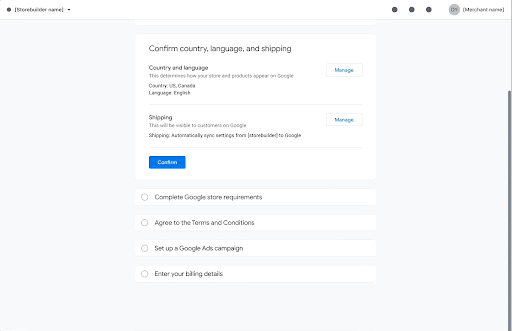เกี่ยวกับคู่มือนี้
คู่มือนี้มีจุดประสงค์เพื่อให้เครื่องมือสร้างร้านค้ามีชุดแนวทางปฏิบัติแนะนำในการผสานรวมสำหรับข้อมูลที่แสดงฟรีและโฆษณาแบบชำระเงิน คู่มือนี้ช่วยให้ผู้สร้างร้านค้า เปิดใช้ผู้ขายด้วยการมอบประสบการณ์ที่ราบรื่น คู่มือนี้จะเน้นให้เห็น API ต่างๆ ของ Google ที่ต้องใช้ในการจัดการบัญชี Merchant Center และบัญชี Google Ads จำนวนมากอย่างมีประสิทธิภาพ ขณะที่ไปยังส่วนต่างๆ ของคำแนะนำ คุณจะเห็นคำแนะนำต่อไปนี้สำหรับทุกส่วน
- บทนำและผลกระทบทางธุรกิจ
- คำแนะนำด้านเทคโนโลยี (API และอื่นๆ)
- คำแนะนำ UX พร้อมภาพหน้าจอ
- ปัญหาที่ทราบและเคล็ดลับ
วิธีใช้คู่มือนี้
ขณะที่ดูแหล่งข้อมูลนี้ คุณจะเห็น 5 ขั้นตอนที่กว้างขึ้นเพื่อการผสานรวมพื้นฐานที่แข็งแกร่ง
- การสร้างบัญชี
- การอัปโหลดผลิตภัณฑ์
- คุณภาพของข้อมูล / การแก้ปัญหา
- โฆษณา
- การรายงาน
ในแต่ละขั้นตอนจะมีฟีเจอร์ที่จำเป็นในการติดตั้งใช้งาน ฟีเจอร์ส่วนใหญ่จำเป็นต้องใช้ แต่บางรายการก็ไม่จำเป็นต้องใช้เนื่องจากปัจจัยต่างๆ มากมาย โดยเราจะกำหนดสถานที่ตั้งของคุณ ที่ที่ผู้ขายกำหนดเป้าหมาย วิธีที่คุณตัดสินใจนำไปใช้ และโปรแกรมช็อปปิ้งที่จะใช้
หลักการออกแบบ UX สำหรับการเริ่มต้นใช้งาน
คุณควรสร้างประสบการณ์การเริ่มต้นใช้งานเพื่อเป็นแนวทางแก่ผู้ขายผู้สร้างร้านค้าที่ต้องการแสดงผลิตภัณฑ์บน Google และเตรียมพร้อมสู่ความสำเร็จตั้งแต่เริ่มต้นโดยการป้องกันข้อผิดพลาดที่หลีกเลี่ยงได้
เราขอแนะนำให้ UX รวมข้อกำหนดในการเริ่มต้นใช้งานข้อมูลที่แสดงฟรีและโฆษณาจากสปอนเซอร์ และระบุขั้นตอนที่ไม่บังคับเกี่ยวกับโฆษณาจากสปอนเซอร์เมื่อจำเป็น (เช่น การสร้างโฆษณาจากสปอนเซอร์ รวมถึงการตั้งค่าแคมเปญ Google Ads และป้อนรายละเอียดการเรียกเก็บเงิน)
หลักการเกี่ยวกับ UX ในการเริ่มต้นใช้งานมี 3 ประการ เราขอแนะนำให้คุณคำนึงถึงขณะออกแบบการผสานรวม
เตรียมความพร้อมที่สำคัญได้ง่ายๆ
เราขอแนะนำให้ใช้วิธีการต่อไปนี้เพื่อช่วยให้ผู้ขายเริ่มต้นใช้งานได้อย่างง่ายดาย
ลดความยุ่งยากในการเริ่มต้นใช้งาน: เราขอแนะนำให้ระบุงานขั้นต่ำที่จำเป็นเท่านั้น
ค่าเริ่มต้นอัจฉริยะ แก้ไขได้เสมอ: เมื่อตั้งค่า ให้เดาอย่างให้ความรู้ในนามของผู้ขาย แสดงตัวเลือกนั้นอย่างโปร่งใส และอนุญาตให้แก้ไขได้
การเริ่มต้นใช้งานแบบ 1 หน้า: แนวทางปฏิบัติแนะนำคือการรวมงานเริ่มต้นใช้งานทั้งหมดไว้ในหน้าเดียว ผู้ขายจะดูงานทั้งหมดพร้อมกันได้เมื่อเริ่มเริ่มต้นใช้งานและในทุกขั้นตอนของขั้นตอนการเริ่มต้นใช้งาน
อนุญาตให้ผู้ขายทำงานที่ซับซ้อนในภายหลัง: สำหรับการตรวจสอบนโยบายเว็บไซต์และการตั้งค่าการจัดส่ง โปรดอนุญาตให้ผู้ขายข้ามในระหว่างการเริ่มต้นใช้งานและดำเนินการให้เสร็จสิ้นในภายหลังได้ จากนั้นแจ้งเตือนและแนะนำผู้ขายให้ทำตามข้อกำหนดต่างๆ ให้เสร็จเรียบร้อย หลังเริ่มต้นใช้งาน
คำแนะนำตามบริบท
เราขอแนะนำให้ผู้ขายทำความเข้าใจผลกระทบของงานเตรียมความพร้อมผู้ใช้งาน และแสดงเฉพาะคำแนะนำที่กระชับเท่านั้นเมื่อเกี่ยวข้องกับงานปัจจุบันที่ผู้ขายกำลังทำอยู่
ความสามารถในการปรับตัว
หลักเกณฑ์เหล่านี้มีการแยกประเภทและมีความยืดหยุ่น เนื่องจากมีผลกับเครื่องมือสร้างร้านค้าที่หลากหลาย เราขอแนะนำให้ปรับให้เข้ากับการผสานรวมของคุณ แล้ว คุณจะเลือกตัวเลือกที่เหมาะกับเงื่อนไขของแพลตฟอร์มมากที่สุดได้ ตัวอย่างเช่น มีการตั้งค่าการจัดส่งสำหรับเครื่องมือสร้างร้านค้าที่ใช้ทรัพยากรแบบเปิดและเครื่องมือสร้างร้านค้าที่มีระบบการจัดส่งที่มีประสิทธิภาพ

ช่องทางติดต่อ
หากมีข้อสงสัยหรือต้องการความช่วยเหลือ โปรดพิจารณาใช้ตัวเลือกต่อไปนี้
การสนับสนุน Content API for Shopping: คุณติดต่อทีมสนับสนุน Content API for Shopping สำหรับการสนับสนุนด้านเทคนิคได้
การสนับสนุนด้าน Google Merchant: ช่องทางการสนับสนุนนี้จะช่วยให้คุณได้รับการสนับสนุนสำหรับคำถามเกี่ยวกับ Merchant Center และโฆษณาจากสปอนเซอร์
ผู้ติดต่อของ Google (POC): หากคุณมี Google POC โดยเฉพาะที่จะสนับสนุนการผสานรวม เราขอแนะนำให้คุณติดต่อพวกเขาโดยตรงหากมีข้อสงสัย
